Robot 3D printing – also called robotic arm 3D printing and robotic additive manufacturing – combines a 3D printer head that extrudes materials with a multi-axis robotic arm to create a much more flexible 3D printer than conventional models.
With its high movement range, the robotic arm is increasingly used for large projects, such as mold-making, large-scale prototypes, artistic sculptures, architectural elements, furniture, and even rockets. It opens up a whole new world of design freedom in 3D printing. The arm can print from virtually any angle, enabling extremely complex, curved geometries. It also provides much larger print sizes than regular printers – up to 30 meters or more!
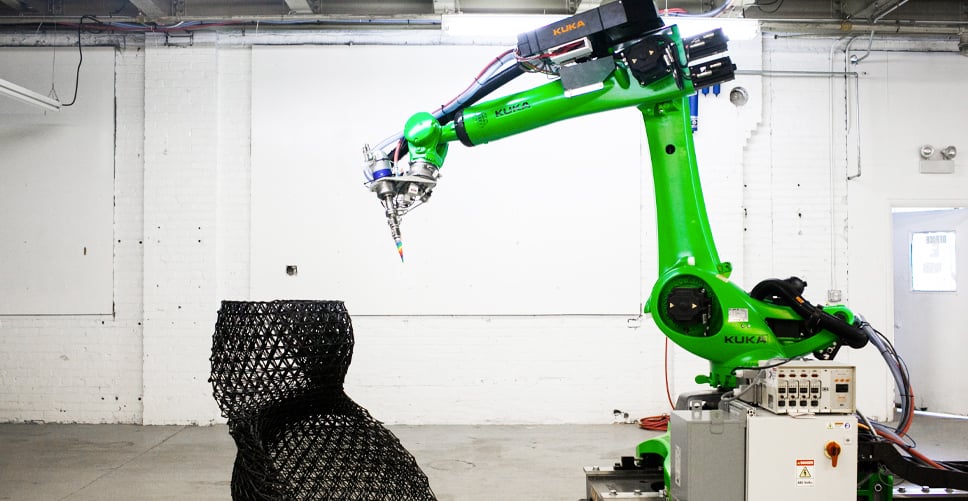
Arms Have Advantages
Printed parts from robotic arm 3D printers generally don’t require supports, which further increases the degree of design freedom and saves money on material costs. This does require the structures to be self-supporting, which would typically rule out overhanging designs. However, many manufacturers have solved this problem by allowing the building platform to be reoriented, making it possible to create overhangs by aligning the extrusion layer with the underlying geometry to use it as support.
Another unique feature of robotic arm printers is that they don’t require slicing software to create the layers as needed with fixed-axis printers, thanks to the multi-axis toolpaths that can be programmed with specialized 3D printing software (see below). This can be an advantage or a drawback since operators must program instructions for the 3D printer head and the robot arm. Program the software wrong, and you could collide your robotic arm with your printed part. Fortunately, more software options today have 3D printing modules that take a lot of the guesswork out of the entire process, and advances in these programs are bringing them closer to a streamlined CAD-to-print workflow.
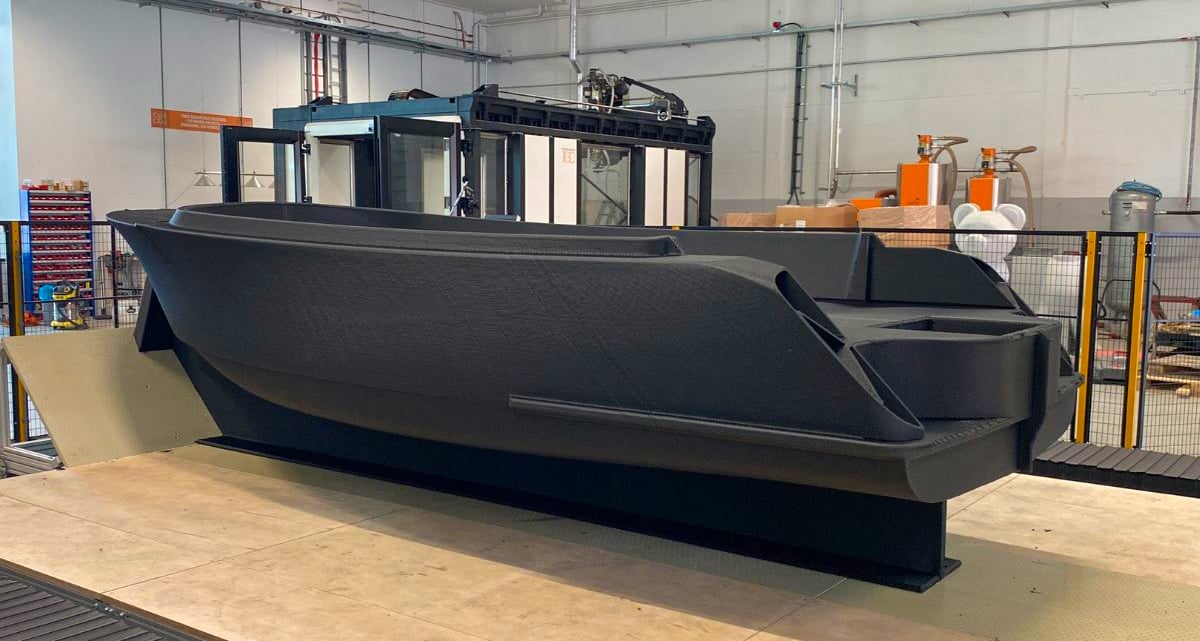
Another distinguishing feature of robotic arm 3D printers is that they are primarily build-your-own. It’s most common for companies to purchase a robotic arm, an extruding unit, software, and other parts separately. In fact, there are just a few ready-made systems available. This factor has kept robotic arm 3D printers from becoming mainstream solutions. Still, the technology is getting more common, particularly in industrial manufacturing, where many companies already own robotic arms and can outfit them with new equipment for new uses.
One UK company hopes to broaden the reach of robotic 3D printing to companies thwarted by the build-it-yourself barrier. Evo3D, a 3D printer distributor, offers a bundled solution that includes a top robotic arm, extruder system, software, and, most importantly, training and support.
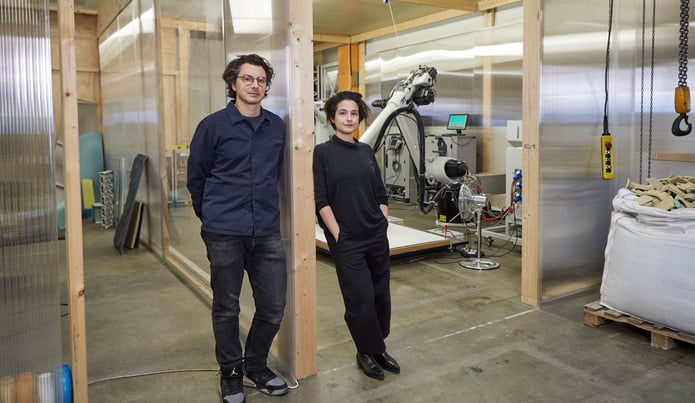
Cheaper, Sustainable Materials
Robotic arm 3D printers do not use giant rolls of filament. Instead, they typically use polymer material in pellet or chip form, but metal, clay, and concrete can also be extruded, given the correct hardware. The extruder mechanism draws the pellets from a central hopper and heats them to create the exact amount of viscosity needed for extrusion. Plastic pellets are used in various industries, including injection molding, so they’re typically vastly cheaper than the plastic filament used in conventional extruder 3D printers. The pellet form also opens up opportunities to mix materials and create custom blends, plus use recycled plastic that’s been shredded. Printing with pellets and shreds is also faster than printing with filament since it’s usually found on larger machines with longer heat zones that enable higher material throughput.
One interesting start-up with a unique take on robotic arm 3D printing is Procode Dress. This fashion studio led by designer Lilach Porges is using a patent-pending robotic 3D printing garment system to fabricate clothing. Using body scanners, the company hopes to be able to produce perfectly fitted outfits to fit every body shape using sustainable materials, the company says.
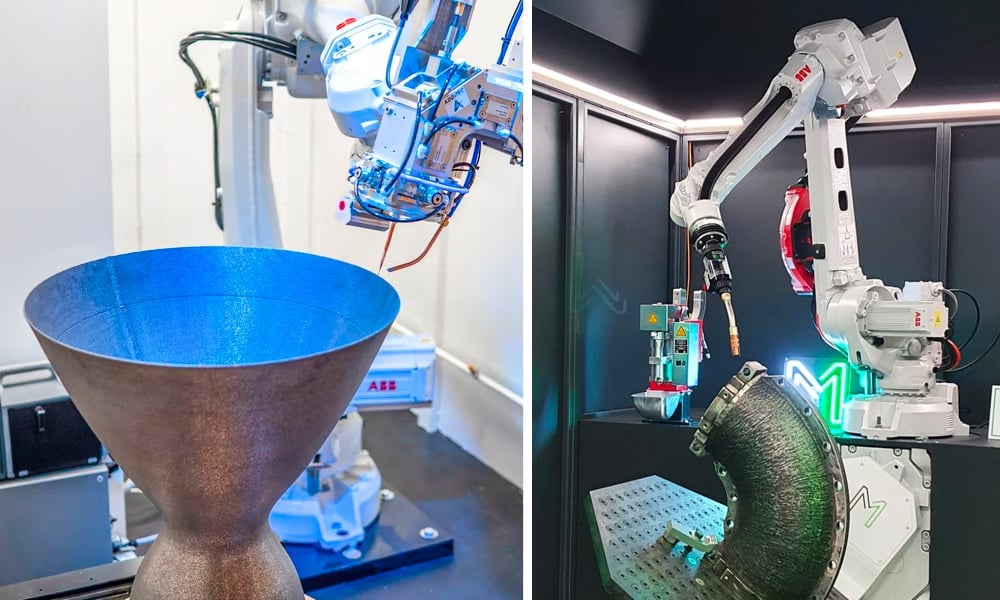
Robotic Arms for Metal & Concrete
Robotic arm 3D printers are not limited to plastics, of course. However, 3D printing with metal and robotic arms typically falls under the wire arc additive manufacturing (WAAM) technology category or the directed energy deposition category, which we cover in separate guides.
Robotic arm 3D printers are also increasingly used with concrete-like materials for projects in construction and architecture. Companies, such as Vertico and Twente AM, offer a variety of robotic arm and concrete extruder configurations for 3D printing walls, benches, planters, and light construction projects. We cover more concrete 3D printers at the end of this article, “3D Concrete Printing – The Ultimate Guide.”
Now that we’ve briefly examined the basics of robotic 3D printing, let’s get into the machines themselves and the applications that illustrate how they’re used today.
Manufacturers of Robot 3D Printers
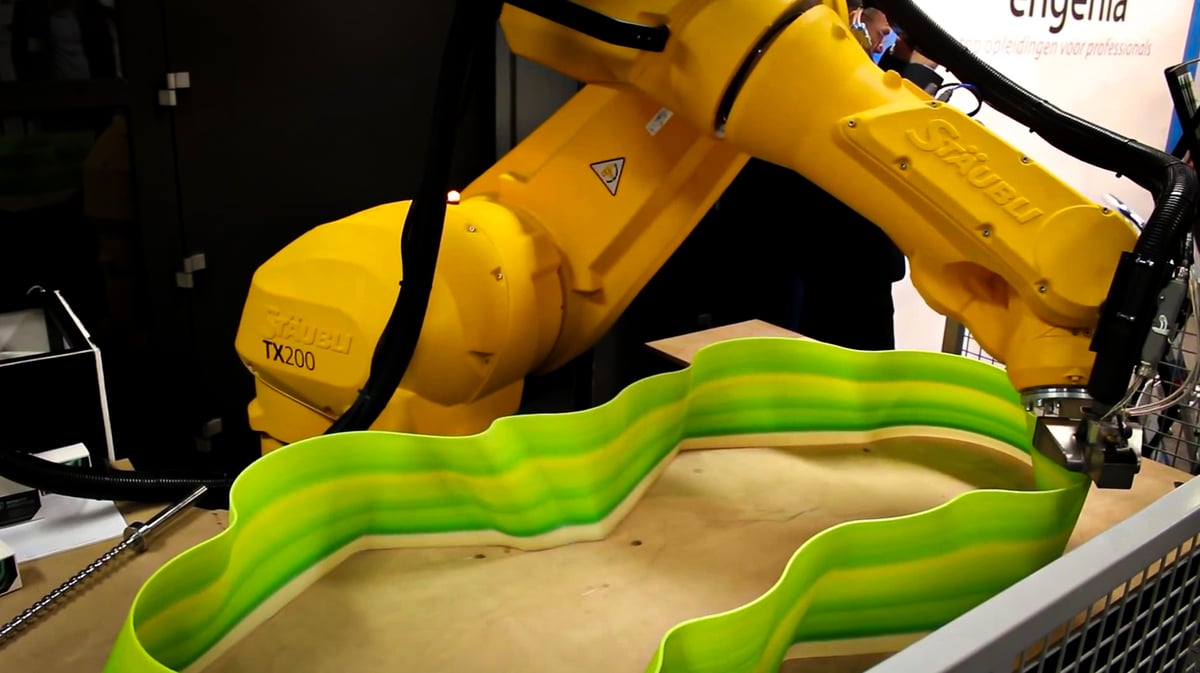
As you may have guessed from the niche nature of robot-assisted 3D printing, the marketplace isn’t exactly bustling with dozens of printer manufacturers. As we mentioned, currently, it’s a bit of a mix-and-match situation where you may buy a robotic arm from one manufacturer and an extruder end-of-arm tool from another. Some companies offer packages, often called cells, that can be customized with different configurations of arms, extruders, and supporting accessories to fit your specific printing needs.
This is why you’ll find far more companies offering robotic arm 3D printing as a service using their proprietary printer than companies selling robotic arm printers. Yet, this is expected to change as more companies see the benefits of robotic arm additive manufacturing.
CEAD
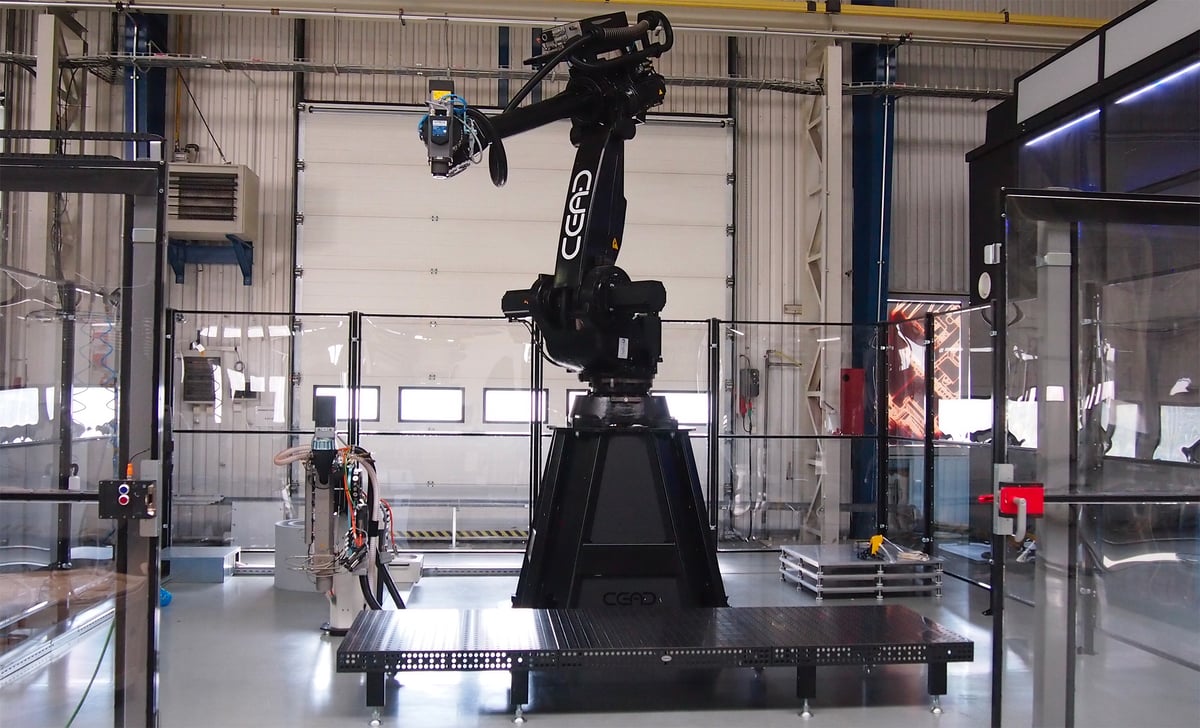
Dutch 3D printing technology supplier CEAD has developed the AM Flexbot, a flexible robotic solution for large-scale additive manufacturing. The modular system is highly customizable, allowing it to be modified to suit various applications and include functions such as CNC milling. In March 2024, CEAD announced a collaboration with robotics software start-up Adaxis. This strategic partnership integrate AdaOne software for large format 3D printing with CEAD’s Flexbot solutions.
Unlike the ABB, the CEAD AM Flexbot comes with an extruder that can handle engineering-grade, high-temperature plastics, such as PET and ABS-carbon fiber. (You can also purchase any of CEAD’s extruders separately, as we cover in the extruder section below.)
Using Siemens’ Sinumerik 840D controller to manipulate the Comau robotic arm across 31 axes, the machine can deliver highly accurate results with a printing table of 1.2 x 1.8 meters. It doesn’t need a separate robot controller, unlike some other solutions.
The Flexbot can be expanded with optional modules that add functions such as a rotary table, a heated working table, and a milling add-on. The latter enables operators to achieve various levels of surface finish for mold-making and tooling applications.
According to the company, CEAD’s Flexbot is compatible with any slicing software, yet recently launched the AdaOne for Flexbot integration. Combined with the arm’s operational flexibility, it is easy to incorporate into varying manufacturing processes.
The Technical University of Munich (TUM) teamed with CEAD to print a mold for a demonstrator composite flaperon for large passenger aircraft. The Flexbot allowed TUM to use their proprietary G-code to control the robot, helping them print molds faster and reduce warping in the final print.
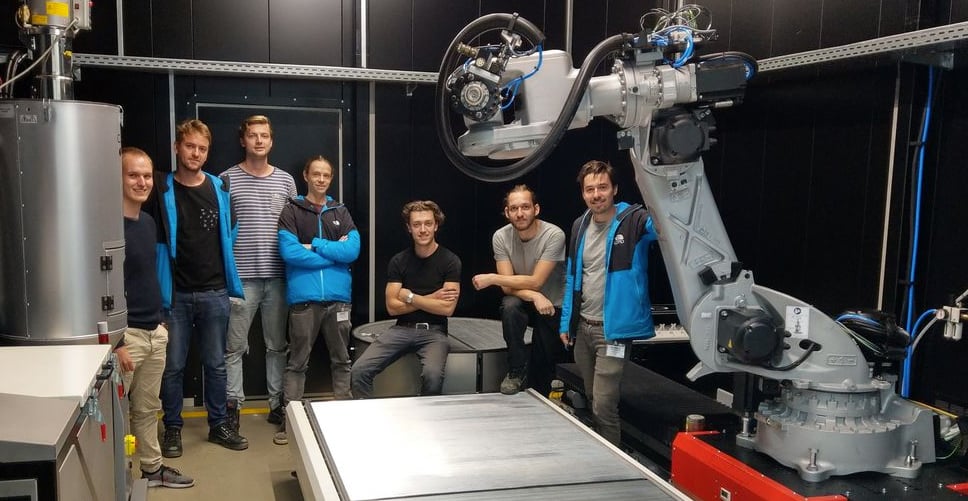
KUKA
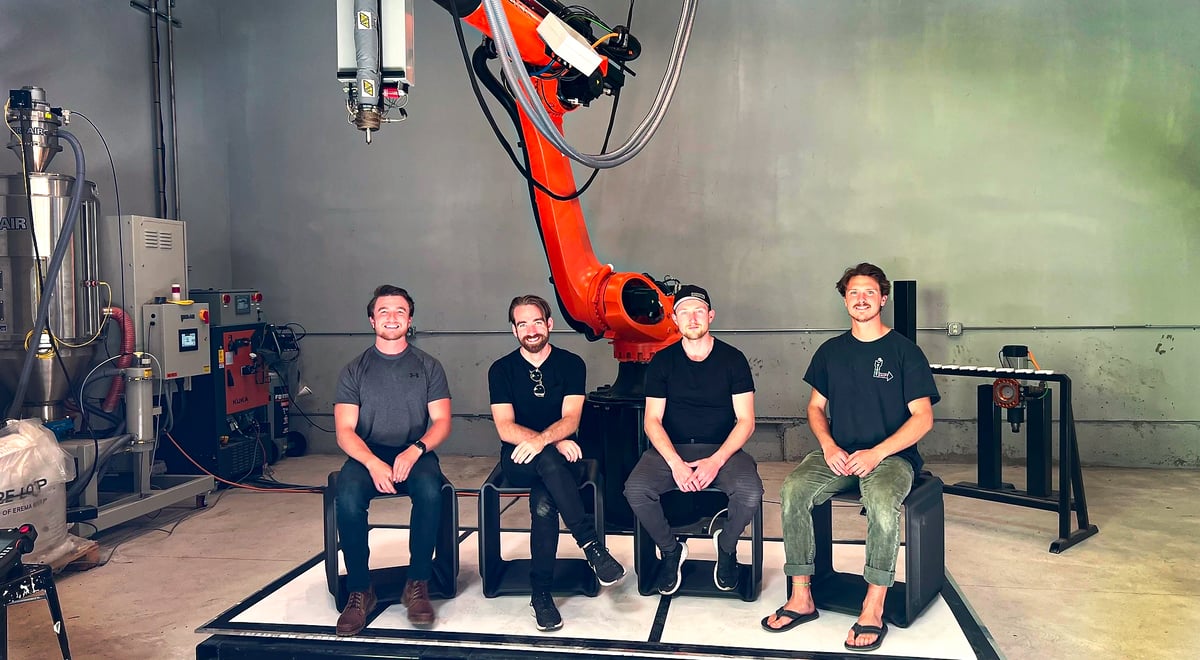
Germany’s KUKA manufactures a variety of industrial robots and automation solutions for multiple industries. Among them are robotic arms for 3D printing, including the KR Quantec, KR 3 Agilus, KR30, and KR Cybertech Nano robots. Just like ABB, KUKA manufactures the arms, not the end-of-arm extruder. However, it does make an end-of-arm laser metal deposition (LMD) system for hybrid metal additive manufacturing called ProLMD.
KUKA’s shelf-mounted robots are able to print parts with a maximum diameter of 30 meters. According to the manufacturer, the 3D printing robots are fast and lightweight, saving space and manufacturing resources.
The KUKA.CNC software can import data from any CAD file after converting it into G-code, a CAM slicer software. The company says its system software allows the entire CAD/CAM chain to be handled in-house without having to compile data into the robot language.

Branch Technology, a US-based prefabrication and technology company specializing in large-scale 3D printing, used a KUKA robotic arm 3D printer to create four colossal hanging gardens (pictured above) for the Chicago Field Museum of Natural History’s 125th-anniversary celebration.
Called Nature Clouds, the project is comprised of 3D printed garden structures made from plant-based bioplastic because steel would have been too heavy. The organic forms, the largest of which is 35 feet wide by 28 feet long, spill over with more than 1,000 plants. The inherent benefits of 3D printing allow for an organic form and modular parts.
Caracol
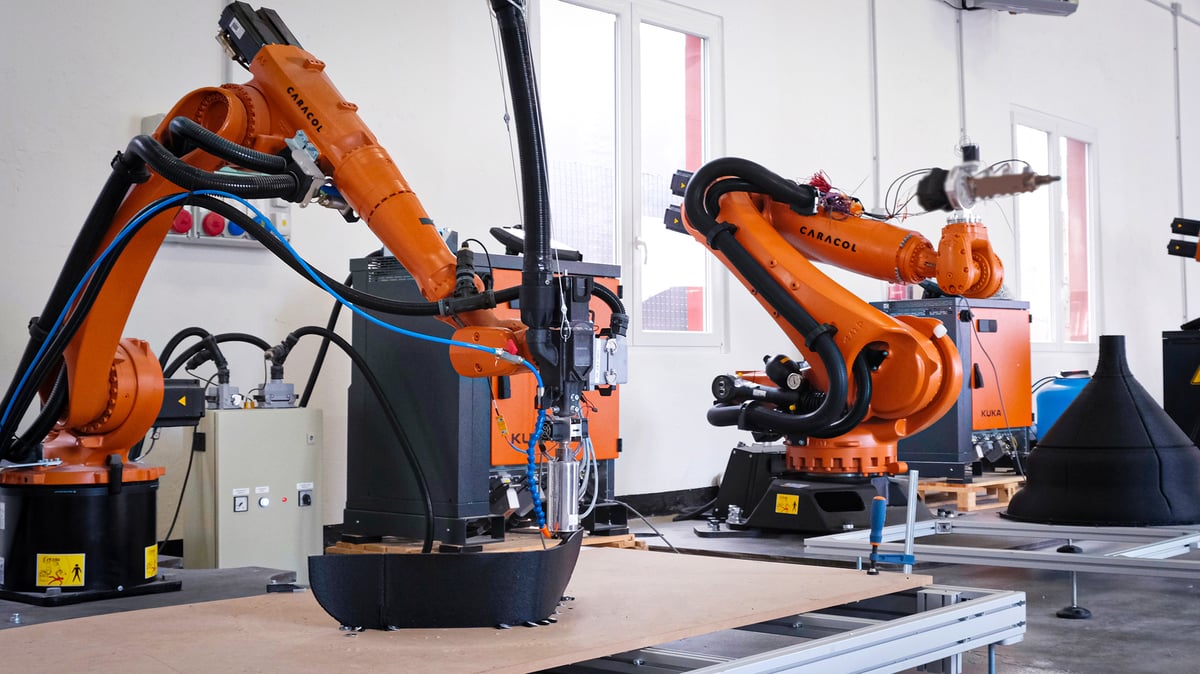
Italy-based Caracol with four facilities and a new HQ in Texas, developed both the hardware and software powering its robotic additive manufacturing service. Originally a service provider, the company is now offering its integrated hardware and software solution, Heron AM, as a purchasable solution in conjunction with machine training and personalized to individual requirements.
Caracol uses its proprietary Scalprum 13800 system – parts of which are patented – with KUKA robotic arms as a support to manufacture large-scale prototypes and finished products, in addition to tools, jigs, molds, and end-use parts. The company says this six-axis technology has no limits in scale and complexity and significantly reduces production time and material costs. The company works primarily today in industry and manufacturing, including in the aerospace and automotive sectors.
Caracol can print in a variety of high-performance and recycled materials, including PEEK, nylon (PA12) reinforced with glass or carbon fibers, PPS (polyphenylene sulfide), TPU, as well as with recycled materials like rPLA and rPET.
Showcasing the technology’s potential for material circularity, Caracol recently used recycled polypropylene and glass fiber to manufacture a 3D printed lamination tool for wind turbines in their RARe-WASTE (Robotic Large Format Additive Remanufacturing from Recycled Waste) project. Responding to the Demo4Green open call by EIT Manufacturing, Caracol claims it managed to decrease lead time by 50%, save on 72% of raw materials, and reduce waste by 90% compared to conventional manufacturing. The company used a combination of additive and subtractive robotic manufacturing using its versatile KUKA arm with different module heads.
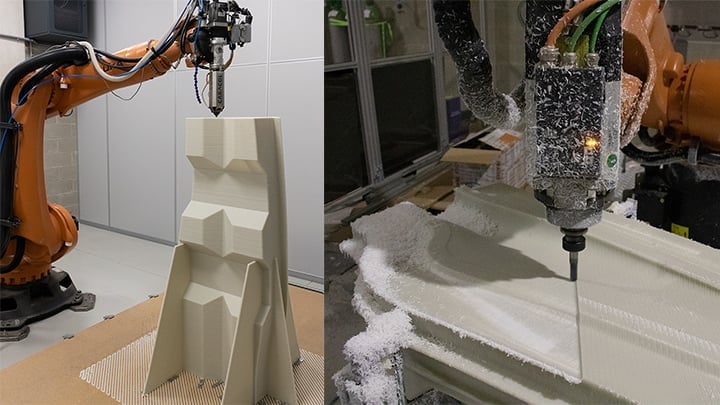
Weber Additive
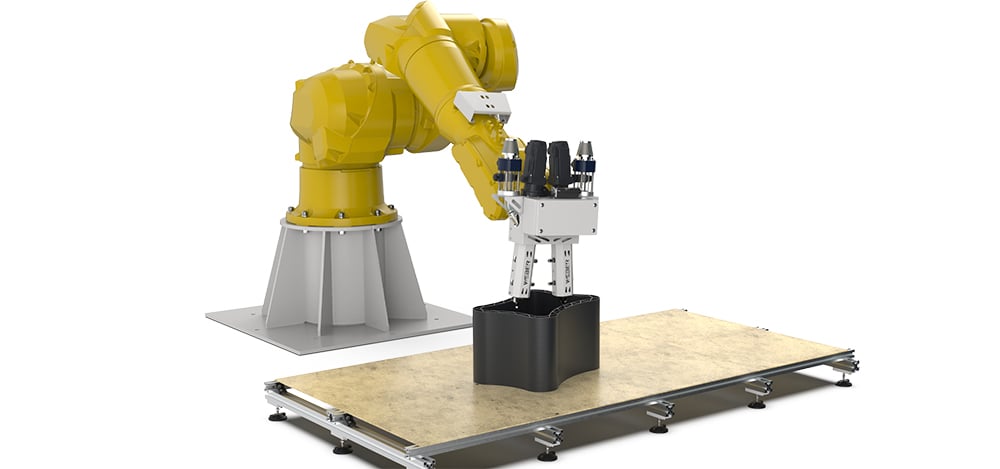
German manufacturer Weber, known for its extruder technology, offers a complete robotic system for additive manufacturing along with extruders that you can also buy separately (covered below in the extruder section). Weber Additive outfits a modular 6-axis industrial robot (an ABB, KUKA, or Stäubli) with one of its extruders (AE 16, AE 20, AE 30) and an enclosure called a robotic cell as a package called the DXR Series.
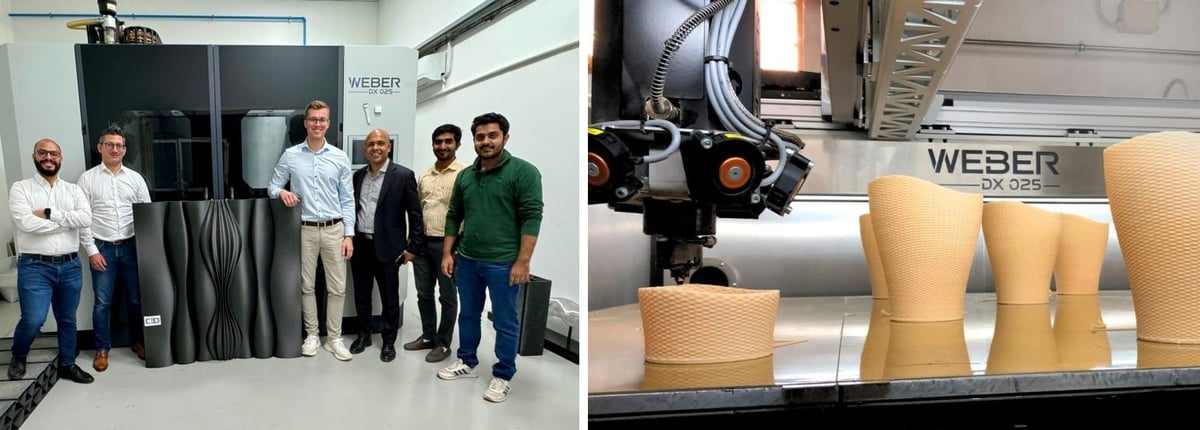
The DXR Series systems work with various industrial robots to move the company’s specially developed extruders. The extruders can reach 450 °C, have interchangeable nozzles, and have a wide range of material options, ranging from soft thermoplastic elastomers to carbon fiber polymers. In addition to the robotic production cells (DXR-Series), Weber Additive’s portfolio also includes systems for direct extrusion with a gantry system (DX-Series) and parts production as a service.
Bloom Robotics
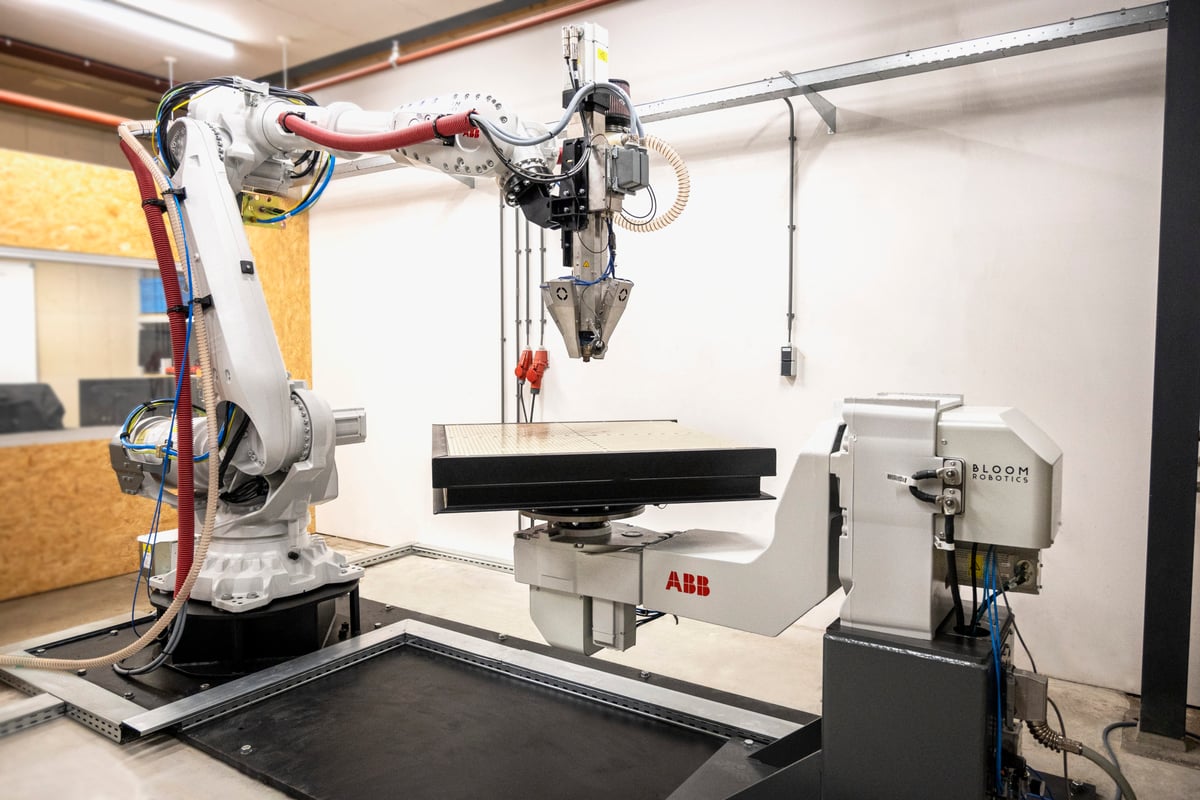
Dutch company Bloom Robotics delivers turnkey serial additive robotics systems for custom-made applications. Using an ABB robotic arm, the company has developed the ADE25 pellet extruder. The printer is capable of processing a wide range of plastics and composites, including PET-G, PET, PP, HDPE, and PP-GF. Other extruders like the ADE30f that works with flakes and ADE30XL for even higher material output are currently in development.
Using a positioner, a rotating build platform, the AR System Cell removes unnecessary support material when printing with a fixed bed, saving material, costs, and time. The cell can also be used for other operations like milling, plastic welding, and gluing and can even be bought as a containerized mobile version. The AR System Gantry sees the robot arm placed on a gantry, enabling even larger size possibilities, able to print at a 20+kg/h print rate.
Wastewater and stormwater solutions manufacturer Pipelife uses the Bloom Robotics printer to manufacture custom-made piping solutions. Pipelife’s R&D project manager Schoenmaker says, “With a positioner, we can continue printing lines directly on top of each other without the need for additional support while maintaining excellent durability and optimal hydraulics.”
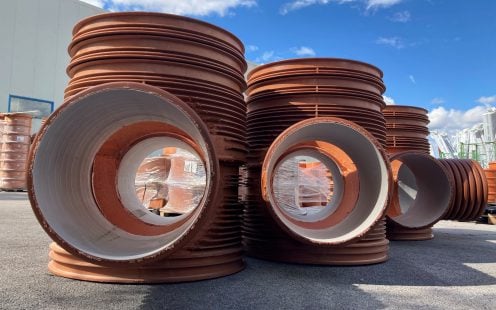
ABB

ABB Robotics, a branch of the Swedish-Swiss manufacturing giant ABB, produces robots and industrial automation solutions for a wide range of industries, including 3D printing. Many of its robot arms, such as the IRB 7600, feature flexible wrist movements and high accuracy, making them highly suitable for additive manufacturing.
Note that ABB only makes the arm, not the end-of-arm extruder. However, the company has recognized the growth and potential of using its arms for additive manufacturing and released a new version of its RobotStudio software that enables controls for 3D printing. RobotStudio is compatible with several ABB robot arms. It supports a variety of additive manufacturing processes and is designed for low-volume, high-mix printing.

Stand-Alone Pellet Extruder Heads

If you’re up for engineering your own robotic arm 3D printer — or you’d like to retrofit a robotic arm or CNC machine that you already own so you can repurpose your equipment for additive manufacturing — you’ll need a pellet extruder. We cover the top options below.
You’ll also need other accessories that many extruder manufacturers also offer, such as a unit that conveys the material from the hopper to the print head, a feedstock agitator, and a cooling fan. You may also want to consider a heated build surface.
Massive Dimension
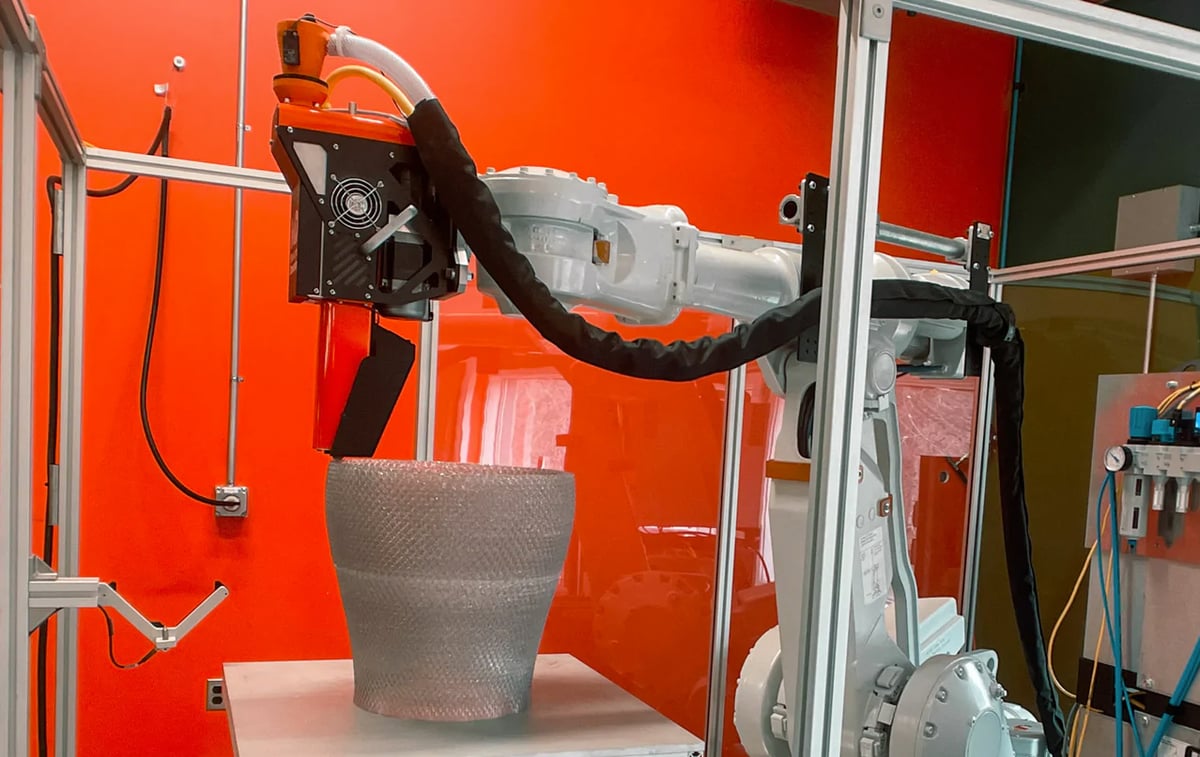
US-based Massive Dimension was created with sustainability in mind. The company aims to promote using recycled and pellet materials through robotic arm 3D printing.
Massive Dimension’s product line encompasses all components needed to convert an industrial robotic arm into a large format additive manufacturing platform. The company has worked in thermoplastic extrusion technology for over a decade through its sister company, Filabot, the filament extrusion machine maker.
The Massive Dimension MDPH2 pellet head extruder ($4,945) is a lightweight and economical option for those looking to break into the frontier of large-format additive manufacturing. The MDPE10 extruder ($14,848) outputs 10 lbs per hour, five times more material than the MDPH2, which allows for shorter print times and thicker walls in a single pass. The largest MDPE10 Industrial extruder ($17,973) is designed for high-volume production, extrusion of highly filled polymers, and abrasive additives.
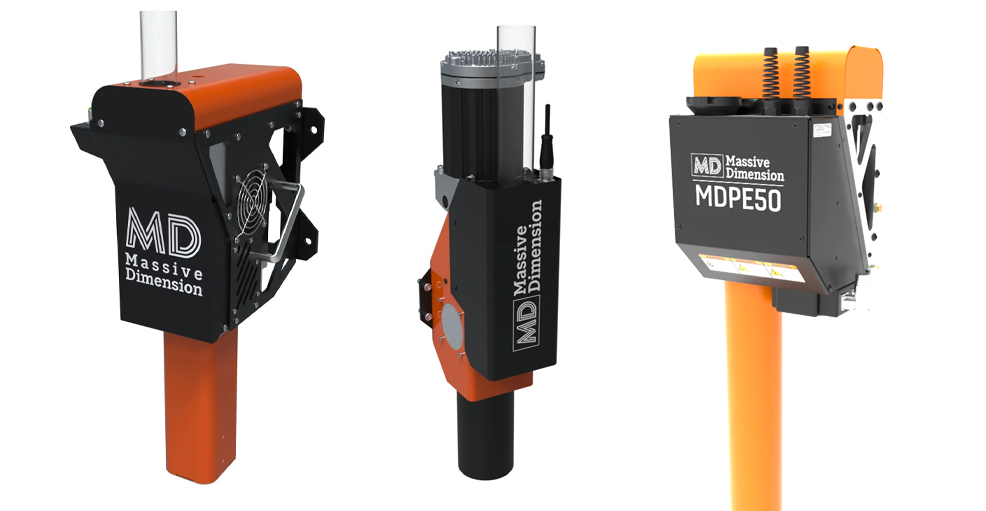
In addition to three extruders that can be fashioned onto robotic arms, Massive Dimension offers turnkey, customizable robotic printing cells for large-format additive manufacturing applications featuring arms from ABB. You can also purchase training services from Massive Dimension and ABB to get you acquainted with your printer, ensuring your operators are well-equipped to begin producing parts without significant downtime or undue print failures. These training services include an overview course on all aspects of the printing process, including slicer software, polymer extrusion, rapid programming, and extruder maintenance.
Dyze Design
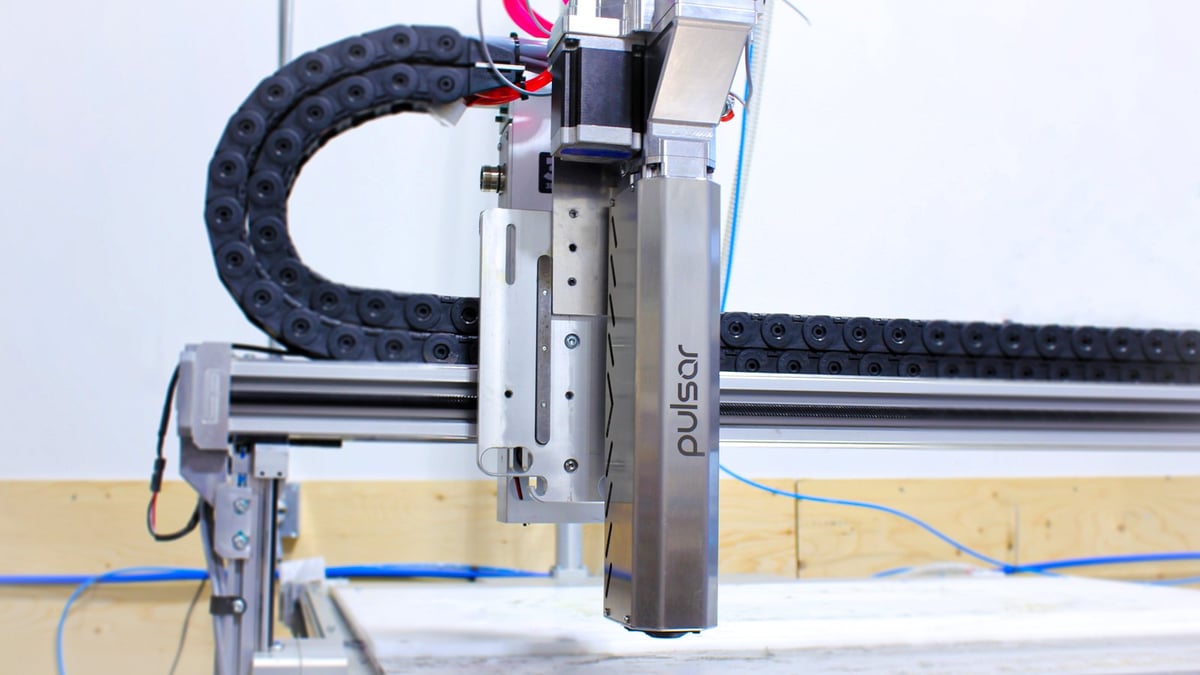
Dyze Design makes a wide range of extruders and hot ends, many of which are the standard equipment on a wide range of branded 3D printers. For robotic arm 3D printing, Dyze offers the Pulsar Pellet Extruder ($10,850) that can be installed on any large-scale 3D printer or robotic arm, transforming it into a pellet printer. New at Dyze is the Pulsar Atom Extruder, available for pre-order for about $4,000, that the company says reaches 450°C with a material output of 800 grams per hour.
The Pulsar Pellet features a high 500 mm3/s throughput, making it one of the fastest pellet extruders available. It has three heat zones, designed to keep the melted plastic transported by its customized extrusion screw at a constant temperature. The Pulsar supports multiple nozzle sizes from 1 mm to 5 mm and can come with an optional automatic feeding system that also detects the pellet level in the hopper. While the extruder doesn’t have retraction, its anti-oozing mechanism should maintain high print quality, the company says.
The Pulsar Pellet can heat up to 500°C, and as such, supports all available types of standard, engineering, and reinforced thermoplastics, whether recycled or virgin.
CEAD

CEAD offers its polymer pellet robot extruders as complete standalone systems, accompanied with a base unit that controls temperature, extrusion speed, and automatic material transport, which ensures safe operations. The extruders are regularly integrated with robot arms and gantry-based solutions.
The extruders are designed to process fiber-filled thermoplastic pellets and can process virtually all short-fiber-reinforced thermoplastic composites, making them widely applicable to many industries. The company also offers a pellet dryer and a proprietary print bed.
The extruders in four sizes (E25, S25, E40, and E50) have max output rates from 12 kilos per hour up to 84 kilos per hour.
Rev3rd

Rev3rd makes pellet extruders and offers pellet-enabled large-format 3D printers and pellet printing as a service.
The company’s extruders feature a quadruple heat zone design that helps keep the polymer at a constant temperature. The feeding section receives cold pellets and generates more heat to melt them. Then, the compression zone stabilizes the polymer at a precise temperature ensuring the plastification process (all the solid pellets turn into a molten status). Finally, the metering heater ensures an even flow. The water-cooling loop keeps the whole system (motor, screw shank, reducer, and feeding zone) at a constant temperature.
The three extruders, RD-M40, RD-M25, and RD-M10, are robot and CNC machine ready and offer various output volumes per hour (40kg, 25kg, and 9.5kg). Each option comes with an optional venturi feeding system that detects the level of the pellets and auto-charges the extruder. Pellets can be delivered from a bulk source or directly from a dryer.
Weber Additive
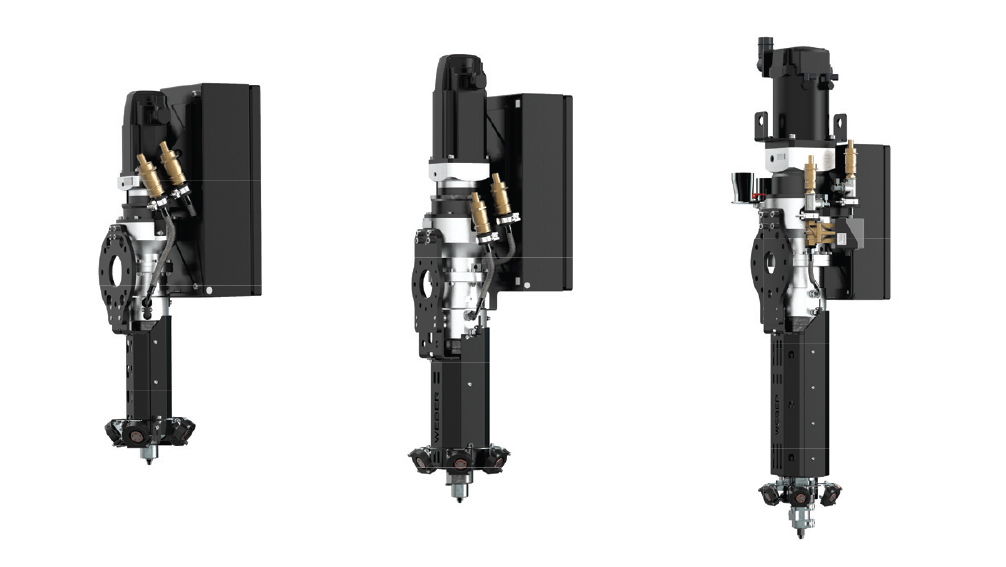
Weber Additive, known for its robotic and extruder technology, can outfit any modular 6-axis industrial robot (a KUKA or Stäubli) with an extruder (AE 16, AE 20, AE 30), and an enclosure called a robotic cell as a package called the DXR Series. If you just want an extruder, that’s for sale, too, upon request.
The Weber extruders can reach 450 °C and feature tempered feeding zones, water cooling, and interchangeable nozzles. They are lightweight, optimized for variable output, and have a powerful servo motor and compact material feeder. The right configuration and size of the pellet extruder depends on many factors, the company says, such as the desired extrusion speed, layer and wall thickness, and material.
Weber Additive’s portfolio includes systems for direct extrusion with a gantry system (DX-Series), robotic production cells (DXR-Series), and parts production for customers on demand.
Software for Industrial Robot Programming
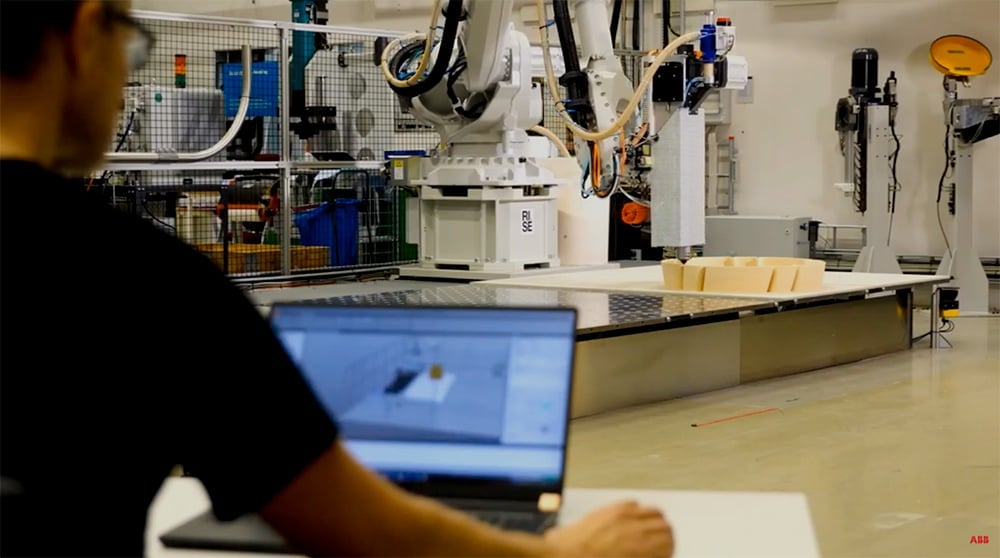
Although some of the robot 3D printers above make it a selling point that they can be used with any slicing software, the fact stands that many machines on the market will not be compatible with typical slicers. Here we cover software solutions that help turn a 3D part file into robot programming.
Robotmaster
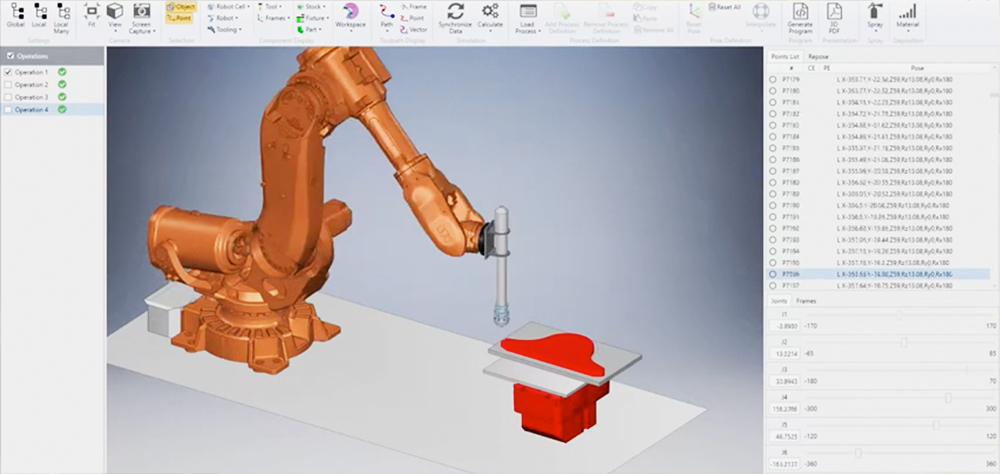
Robotmaster produces CAD/CAM software that helps robot operators integrate offline programming, simulation, and code generation for additive manufacturing. The program features powerful visualization of any issues and errors, making it easier to produce successful prints on the first attempt. The company says that automated programming for robotic additive manufacturing applications can be generated from CAD models and subsequently modified with minimal effort to adjust for all process-based parameters.
Robotmaster’s click-and-drag interface makes it simple to reorient and rework robot arm pathing for optimal print results. It also features single-click contour identification, allowing operators to configure optimized robot programs without learning complex simulation skills.
All in all, Robotmaster automates many of the most challenging tasks in robot programming. The manufacturer says these features enable faster print times and higher part quality.
ABB RobotStudio
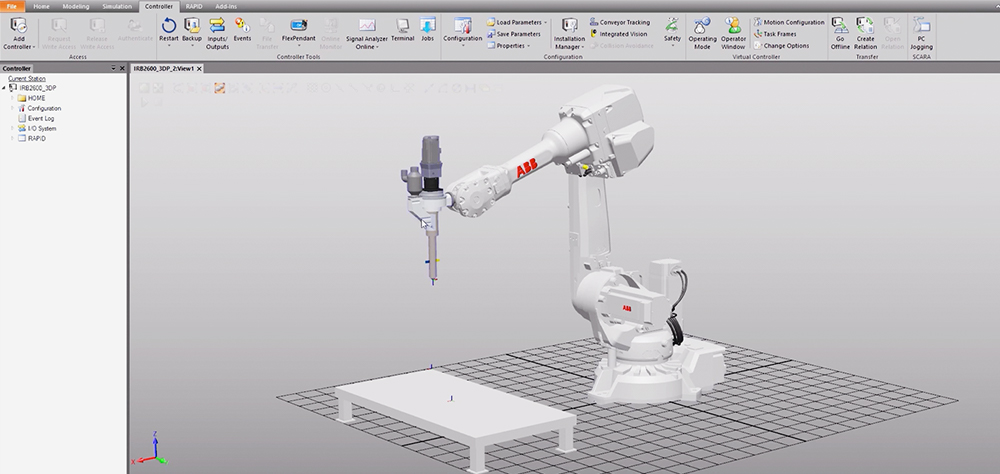
We already mentioned ABB’s RobotStudio earlier. This simulation and programming software allows operators to program the company’s robots for additive manufacturing in less than an hour.
The firm says that belonging to ABB’S PowerPac portfolio, RobotStudio’s 3D printing feature introduced in 2020 removes the need to manually program robot arms, allowing for faster prototyping. The software can translate any standard slicer software design into ABB’s simulation environment and RAPID robot code without the need for manual programming.
RobotStudio features G-code filtering, which removes unnecessary G-code points for smoother robot movement. Including an ABB-compatible extruder screw on the printer allows the program to control extrusion for precise printing.
Ai Build
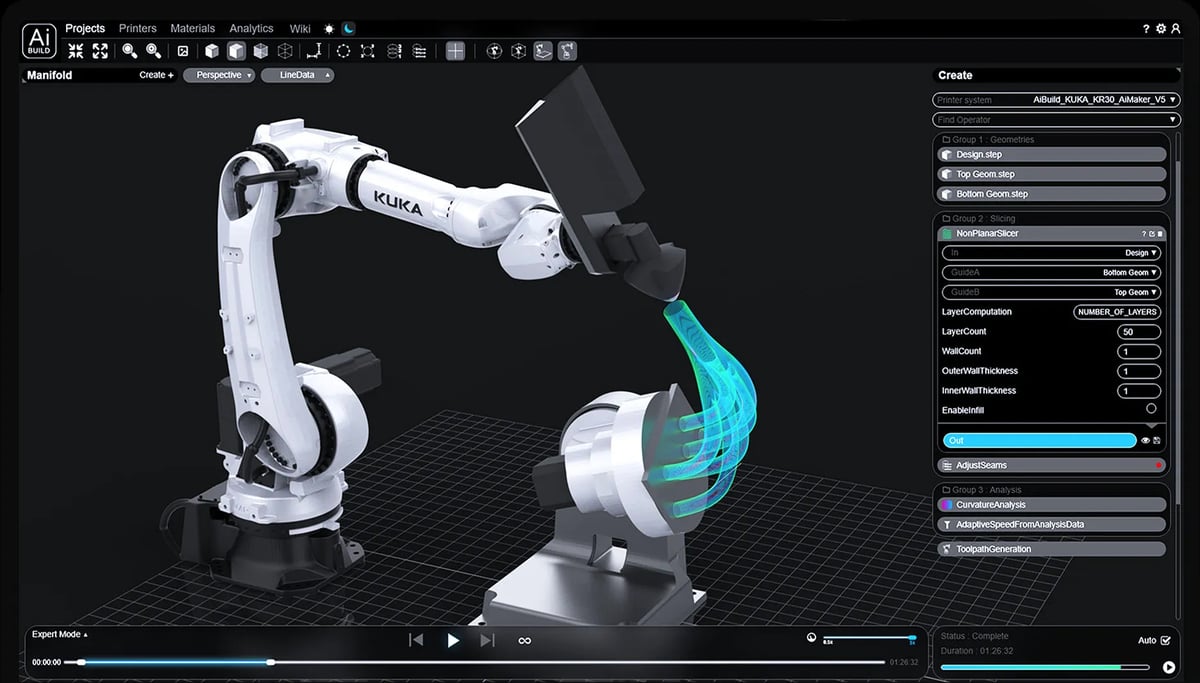
British Ai Build’s AiSync software provides automated toolpath generation, process control, and monitoring workflows for extruder-based industrial 3D printers. The program is capable of controlling multiple printers on one platform with minimal setup.
AiSync produces multi-axis toolpaths that – unlike those created with regular slicing software – are not restricted to layers. The software features a predefined geometrical operator library that makes it easier to customize and optimize toolpaths.
The manufacturer says the software automatically compensates for issues such as warping and layer detachment. Automatic failure detection and predictive analysis functions help operators optimize their printing processes further.
Ai Build currently focuses on software solutions, but the company has also done limited custom printing. AiSync has seen use in multiple applications, including energy, aerospace, automotive, and construction.
Adaxis
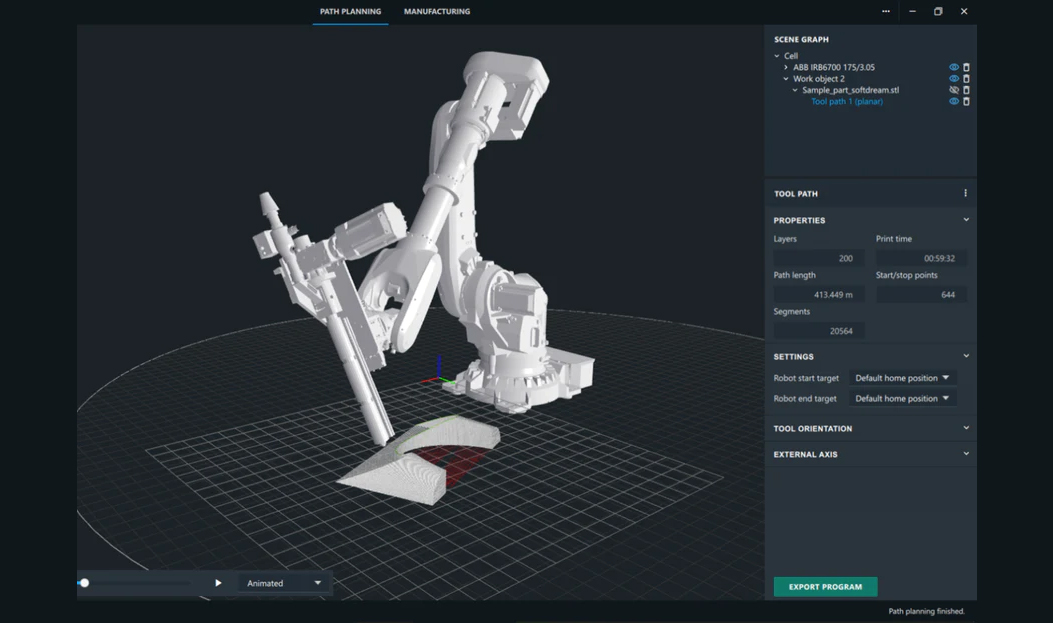
Adaxis is a French-Swedish robotics software start-up with a mission to enable a flexible and sustainable manufacturing industry by making advanced manufacturing processes accessible to every company. They say their software will turn any robot into a flexible 3D printer.
The company’s AdaOne is a robust software for robotic additive manufacturing of metals, plastics, composites, and concrete. The software platform covers every aspect needed to go from idea to finished part, including robot simulation, multi-axis path planning, the all-important collision detection, and robot program generation.
AdaOne is compatible with a wide range of industrial robots and positioners, including ABB, KUKA, Yaskawa, and FANUC, and can be adapted to handle custom kinematic systems up to 14 axes.
Octopuz OLRP
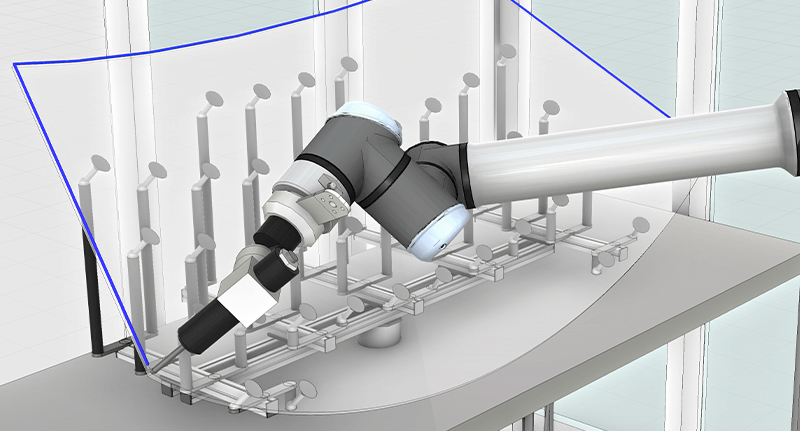
Octopuz, headquartered in Ontario, Canada, released a major 3.0 update to its Offline Robot Programming (OLRP) software in mid-2020. The company added the new PathPlanner tool suite for enhanced path programming.
The Octopuz OLRP for additive manufacturing makes it possible to configure multiple angle settings for high robot movement reliability and accuracy. The new PathPlanner tools let operators create, modify, and transform paths to further enhance arm movement efficiency.
The program is also capable of analyzing material thickness and quality through advanced simulation features. The OLRP supports CAM integration and slicer G-code importing.
Octopuz’s software solutions support robot arms from several different manufacturers. For example, it has been used with KUKA’s robot arms, featured in the previous section.
RoboDK
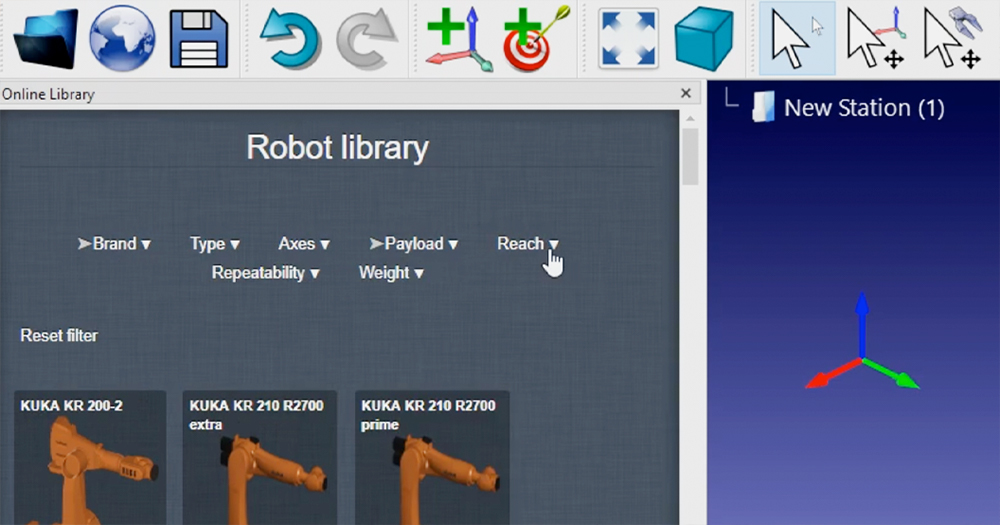
RoboDK is another Canadian software solutions provider. Its offline robot programming software highlights its compatibility with various options – it supports over 500 industrial robots from 50 manufacturers, including ABB and KUKA.
The program allows users to define their tool by simply uploading its 3D model through a simple drag-and-drop interface. This lets operators quickly define their 3D printing head for their robot arm of choice.
The manufacturer says an intuitive, automated CAD/CAM integration interface can quickly create error-free tool paths that avoid collisions, singularities, and axis limits. Generating the final robot path in RoboDK requires no programming experience. The automated two-click process works with more than 70 post-processors that guarantee support for an astonishing variety of robots.
Operators looking for a one-size-fits-all software solution should give RoboDK a look. The company constantly adds support for new robots based on user and manufacturer recommendations, so the odds of it not working with your robot arm are fairly low.
Robotic 3D Printing Service Providers
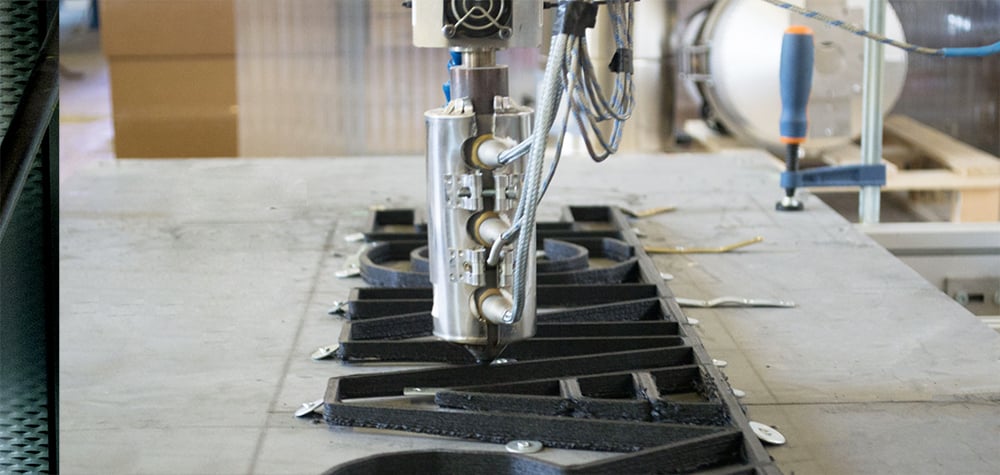
As is usually the story with industrial 3D printing, purchasing your own machine is an expensive proposition – doubly so with advanced industrial robots. Especially for smaller creators, it can be a better idea to hire a third-party service provider to print your part for you.
The companies listed below all have robotic arm 3D printer solutions available. This is by no means an exhaustive list, but these service providers will get your part printed no matter your application, from architecture to furniture. Also, check out our guide to large-scale 3D printing services for more large 3D printing options that aren’t necessarily robotic arm.
Nagami Design

Nagami Design in Spain brings 3D printing and robotic manufacturing to large-scale products and objects with various customization possibilities. Research and innovation are at the core of their products, developed in collaboration with internationally renowned designers who challenge the technology to create groundbreaking products.
Together with UCL Design Computation Lab, Nagami created the Voxel-Chair v1.0 from a 2.4km continuous line of plastic, which was melted and solidified mid-air, creating a new level of intricacy. The Voxel Chair is the first prototype designed using a new design software developed explicitly for robotic 3D printing. The software is based on research led by Manuel Jimenez Garcia and Gilles Retsin at the Bartlett School of Architecture, Design Computation Lab.
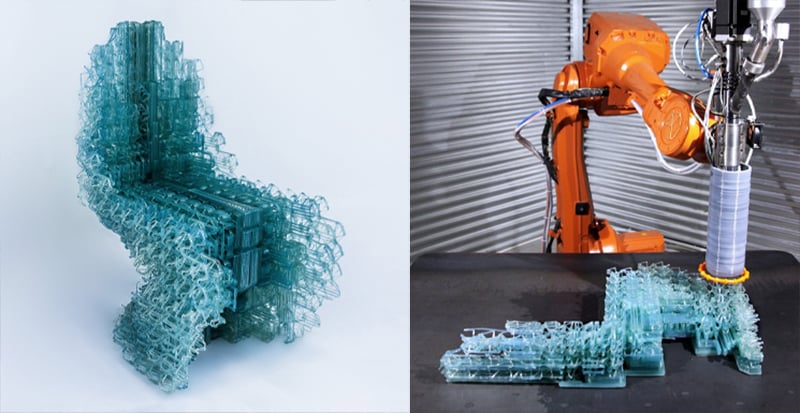
Branch Technology
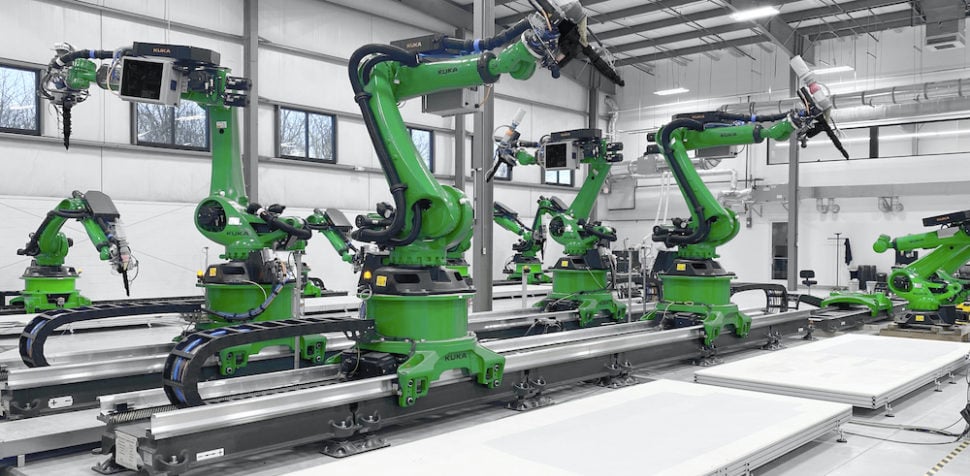
We already mentioned Branch Technology in our entry on KUKA for their collaboration with a botanical garden. But you, too, can hire these innovative design and manufacturing experts for your architectural projects.
Branch Technology’s C-Fab (Cellular Fabrication) technology creates a 3D printed freeform polymer matrix filled with a composite material that is finished with a façade panel and connections. The method uses 20 times less material than traditional layered printing, offering a higher strength-to-weight ratio.
In 2019, Branch teamed up with the University of West Florida to create an art installation for its campus. The final creation was a pavilion 3D printed with Branch’s C-Fab method, which allowed the pavilion to be durable and lightweight while enabling a high degree of design freedom for its parabolic shapes.
Aectual
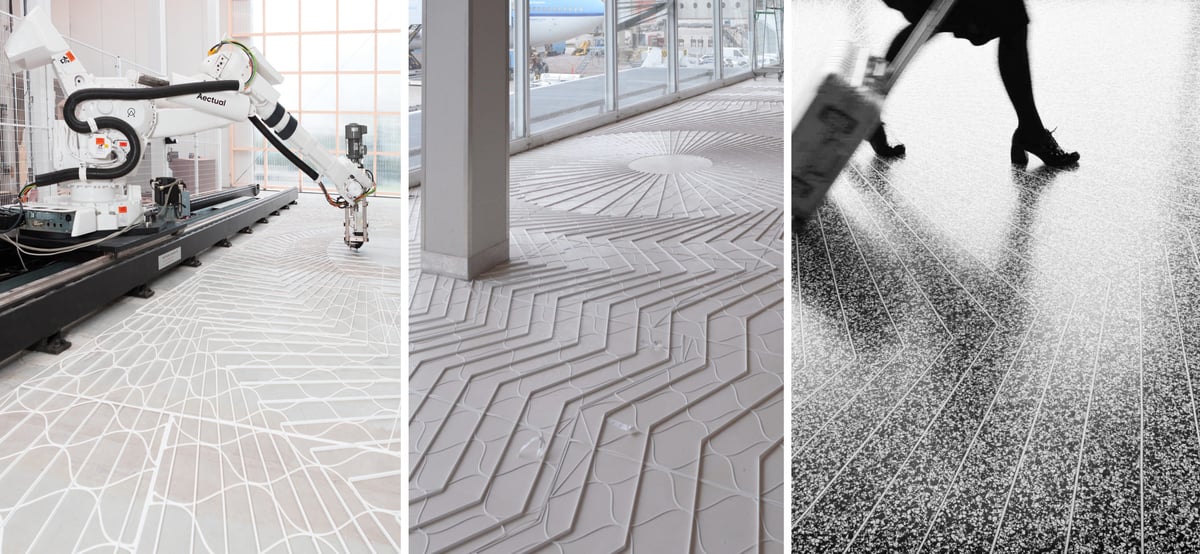
Dutch design company Aectual creates interior and exterior furniture and architectural elements. The company has actually developed its own XL 3D printing system, utilizing an ABB robot arm and IRC5 controller, a custom industrial extruder, and Siemens PLCs. The 3D printer package is also available to purchase for selected partners.
Aectual can print in a variety of materials, from concrete to bioplastics, terrazzo, and recycled waste plastics, like Tetra Pak packaging. Launched in 2022, Tetra Pak is committed to fitting all of its offices with 3D printed furniture made by Aectual and from their recycled containers. It offers large-volume prints, with a 500 sq ft printing area at its Amsterdam facility.
In January 2021, Aectual launched its Aectual Community, which allows members to get their furniture designs custom printed. In 2019, the company worked with acclaimed Spanish architect Patricia Urquoila, printing her flooring designs for that year’s BMW Welt exhibition in Munich.
Lead image source: Bow by Zaha Hadid Architects for Nagami Process ©Nagami
License: The text of "Robotic Arm 3D Printing – The Ultimate Guide" by All3DP Pro is licensed under a Creative Commons Attribution 4.0 International License.


